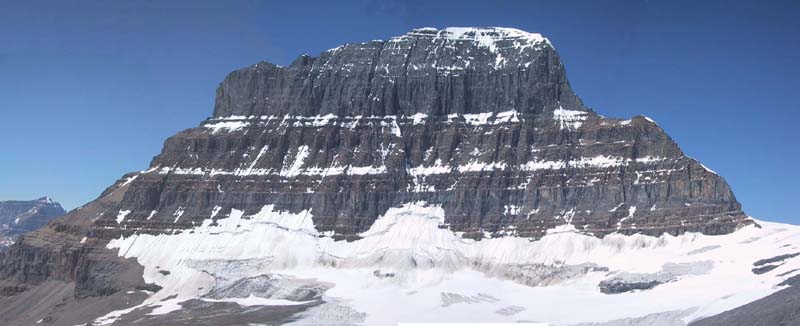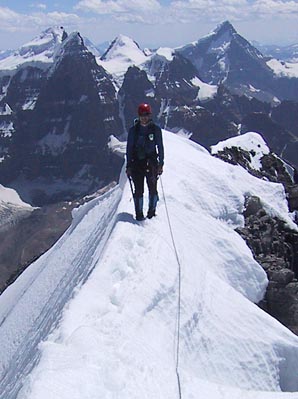
John Prater on Mt. Alberta's summit ridge.
|
Canada 2003
By Bill Wright
(bill@wwwright.com)
Photos by George Bell
(gibell@comcast.net)
Written August 2003; Trip dates July 25 - August 3, 2003
[Click on any image for the full size version]
|
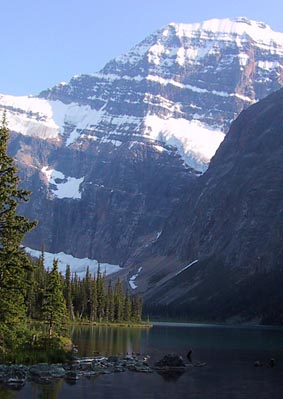
The North Face of Edith Cavell.
|
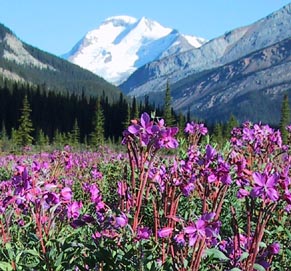
|
Mt. Athabasca from the Sunwapta River Crossing.
Taken the day before during a reconnaissance.
Copyright © 2003 by
George I. Bell
|
To me it seems that "alpine" climbing is the most adventurous type of climbing
one can do. It also seems that no beginner or even intermediate climber would
refer to themselves as an "alpinist" like they might call themselves a trad
climber or a sport climber. No, it seems that the moniker, the title, actually, of
"alpinist" seems to be reserved for the upper echelon. Hence, I don't refer to
myself in such terms, but I do like to dabble in the alpine realm
occasionally.
Mark Twight wrote "Alpinism defines mountain climbing reduced to its purest
essence." This from a man who typically eschews summits. So what is alpine
climbing? It is climbing up mountains, as opposed to just on cliffs. It is climbing
while carrying all your gear and not using fixed camps and other people to assist
you. The mountains we sought in Canada were mountains that we'd typically
need more than a day to climb, but there are always options to compress things.
How long is a day? In Canada there was currently 17.5 hours of daylight. That
would be useful.
The Canadian Rockies are home to countless beautiful, interesting mountains.
Even narrowing the choices down to ones with routes I could manage would still
leave a lifetime of routes to choose from. Hence, I used Fifty Classics Climbs to
narrow the field further. I've done thirty of these routes and really enjoyed all of
them. The final requirement was that no one in our party (myself, the Trashman,
Loobster, and Homie) had done them before. The only hurdle here was the
Trashman's prodigious climbing record in Canada. We were left with just three
choices: Mt. Alberta, Mt. Edith Cavell, and Mt. Robson. The latter is a
monstrous mountain, the largest in the Canadian Rockies, and one that is rarely
climbed. It frequently goes a year without a successful ascent. Plus the
Trashman had attempted the 50CC route on it and thought it was
horrible.
The Loobster flew out to Colorado from the Bay Area on Thursday morning so
that he could join us for the RV trip north. The Trashman was already in
Canada, having gone a week earlier with his wife. We made a plan to meet him
at Sunwapta Pass at 7 p.m. on Saturday night. We drove 24 hours straight to
meet him, rotating drivers every 2-3 hours. We'd sleep most of the time when
we weren't driving, but eating and reading also occupied us. The Loobster was
driving when we crossed the border. He'd make a great smuggler because he's
such a smooth customer. The border patrol asked him, "Are you carrying any
alcohol or firearms?" The Loobster hesitated in his answer, knowing about the
refrigerator stocked with beer, and then said, "No." There was another pause and
he thought better about lying and then said, "Well, a couple of beers, I think."
He had personally bought and placed a case of beer in the RV. He must have
looked harmless though, as they waved us through.
Mt. Alberta

|
Wake up call crossing the Sunwapta River.
Copyright © 2003 by
George I. Bell
|
Mt. Alberta is a gorgeous, historic mountain with no easy route to the summit.
The 50CC route is known as the East Face or the Japanese Route since a team of
Japanese climbers made the first ascent. It is rated 5.6, but if you think "only
5.6?" then you know little about alpine climbing in the Canadian Rockies.
Alberta cannot be seen from any road, and I doubt it has ever seen a one-day
ascent from the car. Most parties spend at least four days on the roundtrip.
In order to approach Mt. Alberta, one first has to wade the Sunwapta River.
This river isn't very deep, but it is wide and fresh from a glacier. When we
crossed it at 7:15 on Sunday morning, it was frigid and my idea of crossing in a
simple water moccasin and no socks was a bad one. Blessed with sensitive feet
and little tolerance for discomfort, this was a near religious experience. I say
near, because there was a heck of a lot of cussing involved. It was estimated that
I said twenty cuss words per braid crossing. On the return trip, I'd get smarter. I
crossed in my mountain boots with my wool socks. It was also in the afternoon
and the river was quite a bit warmer. It was also a bit deeper then, but the only
part of me that got chilled was my calves.
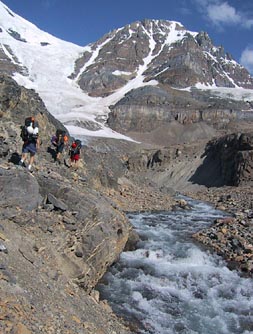
|
Crossing under Diadem Peak
on the endless approach march.
Copyright © 2003 by
George I. Bell
|
After crossing the river, changing shoes, and stowing our soaked pairs in the
trees, we re-shouldered our packs and trudged up the well-defined climbers' trail
leading up Woolley Creek. This trail started with a very steep climb through a
moss-floored forest. Afterwards we hiked right next to, over, and sometimes in
Woolley Creek. We kept our feet dry on this section, but lots of rock hopping
was involved. Eventually we got to the moraine coming off of Mt. Cromwell.
We hiked over endless, giant talus blocks and through numerous spider webs.
On the way out, we'd read the route description better and hug the creek through
this section, finding a reasonable trail.
We entered a box canyon below Mt. Woolley and Diadem Peak with huge
glaciers and their ice falls above us. The mountains up here are so awe-inspiring
and beautiful. We now had to make the horrific trudge up to Woolley Shoulder.
When I first heard "Woolley Shoulder", I figured it was called "Woolley"
because it was covered in trees. It wasn't. In fact, for the last three hours of this
hike there is no vegetation taller than about six inches and mostly there isn't
anything growing except lichen. This is a very stark place consisting of talus
everywhere. The hike to the shoulder was the most unpleasant part of the entire
trip, made more so by a terrible route finding decision I made when I started up
the final slope too early. As a general rule, one should follow the talus gullies
and not the talus ridges, hoping to find at least some snow in the
gullies.
At the Shoulder, which is really a pass between Woolley and Mt. Englehard, we
met a group of eight climbers on their way out. They had stayed in the hut the
night before and had just climbed the snow gully route on Mt. Woolley. They
were headed back to the highway and informed us that the hut was empty. Our
original plans of continuing on beyond the hut to the high bivy suffered their
first blow. The final blow came after we stumbled down the talus on the
opposite side and slogged across the glacier to the hut. Here a vicious case of
Hut Lassitude struck down all four of us. It had taken six hours and over 4000
feet of climbing to reach the hut, and I didn't want to carry these heavy loads
any further. I proposed a one-day ascent from the hut, going as light as possible
and taking advantage of nearly 18 hours of daylight. It was accepted and we
lounged and slept some more. Then we ate and ate and drank in an effort to store
enough fuel in our bodies for the long push the next day.
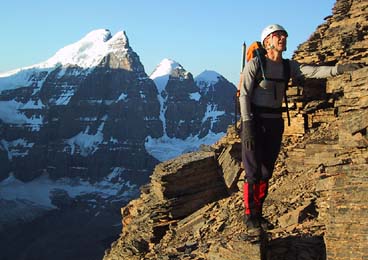
|
The Loobster contemplates our fate.
North and South Twins behind.
Copyright © 2003 by
George I. Bell
|
The alarm went off at 3:15 and we moved about slowly. I stayed in my bag for
another fifteen minutes, as I wasn't going to cook anything for breakfast. I just
nibbled down two Pop-tarts while lying in my bunk. The previous evening the
Loobster and I scoped the approach from the hut. The hut is perched on a rib of
rock next to a mountain called Little Alberta. From here we had to drop down
700 vertical feet, cross the rock-strewn glacier and then start up Mt. Alberta. The
previous night the Loobster and I scoped the best way to get down off the ridge
upon which the hut is perched. We could have dropped down on rock slabs
directly from the hut, but that would have deposited us on an ice patch of the
glacier and would have involved lots of talus walking. We had decided that it
was easier to head out onto the glacier immediately from the hut as the going on
the snow was so easy on our bodies, at least while headed downhill, and the
footing would be easier in the dark. This involved making a large semi-circle
towards the Northeast Ridge of Alberta, staying on snow as much as
possible.
We weaved through some crevasses, unroped, and down onto some rock slabs.
We connected up snowfields whenever possible, but hiked a lot on a glacier of
pure ice that was covered in a thin layer of rocks. Whenever we were careless
and placed a boot on the ice itself, we slipped immediately. Making a beeline for
the far left side of the East Face, we trudged up an increasingly steep snowfield.
Without crampons and kicking very marginal steps, things soon got pretty dicey
and I traversed back down to the talus below the snow.
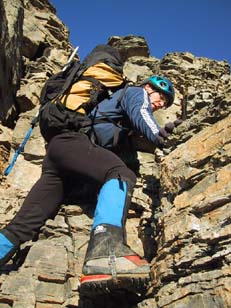
|
Bill leads us through the lower cliff bands.
Copyright © 2003 by
George I. Bell
|
Alberta is made up horizontal stratums of cliff bands interspersed with steep,
loose talus slopes. We needed to get through two or three bands before we
traversed far back to the right to start the roped climbing. How to do this wasn't
obvious and no guidebook or even trip report described it very well. Perhaps it is
just too difficult to describe. We passed through the first cliff band via 3rd/4th
class scrambling just left of the snow slope. Once through that a giant cliff
loomed above us. We had assumed from the photos marking the route that we
had to traverse all the way to the left skyline and probably go around the corner
onto the southern exposure where we'd find a passage through this
cliff.
We traversed just a bit, around the prow of the cliff and were daunted with the
long talus slope and big snowfield leading way up and left. We knew our route
was up and right from our location and the prospect of going so far left did not
excite me. I wanted to climb up the mountain more directly. I told the others to
wait a second while I scrambled up a diagonal ramp and back around the corner
to the right. I climbed up a couple hundred feet and it looked like the route
would go. I called down for the others to follow. I certainly hoped I hadn't made
a mistake. If we got cliffed out an hour above us, we'd have seriously impacted
our chances of success.
We made continuous progress up the cliff band without having to rope up.
Short, talus sections broke short, steep sections. Here the rock was layered in
two to three inch plates and we all became very adept at the pinch move. We'd
pinch a layer above us and step up onto the flat edges. It was fun scrambling and
we gained height rapidly, eventually coming to a low 5th class chimney adjacent
to a snowy couloir. We climbed up, still unroped, and crossed the top of the
couloir via more steep climbing. We found a huge, elaborate rappel anchor here
consisting of a section of climbing rope leading from the rappel ring fifty feet up
the slope to a shiny new bolt, the only bolt we saw on the mountain. Above here
was one of the only cairns on the route. Apparently climbers knock down any
cairns on this route as they descend. Maybe it is part of the same brotherhood
that restricts any useful information about the lower section from escaping to the
general public.

|
Scary unroped scrambling below the "elephants asses".
Arrows point out 3 climbers. Taken on the descent.
Copyright © 2003 by
George I. Bell
|
We were now on the talus ledge system below the major cliff band leading to
the summit ridge. This cliff band is over a thousand feet tall - taller than the
popular Yamnuska cliff near Canmore. This was the meat of the route, but
finding the right location to start up was difficult. The guidebooks told us to
look for three bulbous buttresses of gray limestone that resemble elephant asses,
complete with tails. Finding three of these things takes the creativity of
interpreting Rorschach ink blots. We found one elephant's ass and, yes, it did
have a tail on it, but it took some imagination. The other two couldn't be found
by us. My son Daniel can see all sorts of things in the cloud formations, and I'm
sure he could have recognized a couple more asses up here.
Traversing the ledge here was not trivial. The talus is very steep and very loose.
There is also quite a bit of snow up here that needs to be avoided and all of this
is above a thousand-foot cliff. We traversed looking for what we thought was
another key landmark: the high bivy spot. We never found that either.
Eventually, I climbed straight up the steep, loose slope and then up 65-degree,
soft snow. This was a bit dicey and I slipped down a couple of times. I was
headed for a fixed anchor at the base of the cliff band and as soon as I got there,
I clipped in and geared up. I called down to the others to don their harnesses and
I'd throw down a rope from my perch.
Soon the Loobster had joined me and put me on belay. We were planning on
climbing as two teams of two. I'd pair with the Loobster. I was below a
weakness in the wall and quite probably the start of our route, but I was troubled
by not seeing any rappel anchors above me. The description said that the correct
gully to climb would have rappel anchors at regular intervals. Since we were
climbing up the easiest route to the summit, we'd also be descending the exact
same path. As it turns out that wasn't completely true. We'd retrace our steps
exactly except for the first three pitches of the route and this caused us some
consternation.
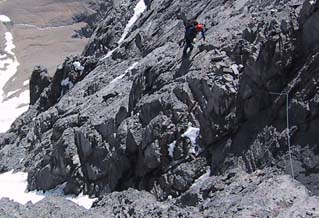
|
Homie following the gully crossing pitch on the upper cliff band.
Copyright © 2003 by
George I. Bell
|
Not sure that I was in the right spot, I traversed a very steep snowfield to the
right and then further right on steep, loose ground, trying to see what was around
the corner. I came face to face with a dead vertical wall of limestone and knew
no route existed up that precipice. I retreated back to the gully above our belay
and started up it. I could get in a piece just before leaving the snow behind and
climbing up onto steep limestone. The climbing demanded care for it was steep,
loose rock with long runouts between gear placements. Just before I ran out of
rope (each team climbed on a 9mm 50-meter rope), I got to a ledge with some
cracks for an anchor. I brought up the Loobster. The Trashman led up, closely
following the Loobster, and pointed out a six-foot arch above us on the left. We
all thought, "What a prominent feature. If this is the correct start, that should at
least be mentioned somewhere in print, yet it is not." The Trashman noticed
some hanging tat on the left, so on the second pitch I made a 60-foot,
unprotected traverse across a rounded buttress and into the adjacent gully. I
didn't start up this gully originally since it was a waterfall at the base of the cliff
band. Up higher, I could step over it and then up into a corner system with
another crack for a belay anchor.
While the Loobster followed the second pitch, the Trashman climbed directly
above our first belay. He reached the same ledge upon which I belayed, though
much further to the right. Unfortunately, he couldn't find any anchors that would
even hold body weight. As he traversed along the ledge looking for gear he
rained serious rockfall down upon Homie. Thankfully, Homie could duck out of
the way behind a steep wall. Finally, with purely decorative anchors but using a
hopefully secure stance on the large ledge, the Trashman yelled down, "Okay,
you're on belay, but don't fall. Ha, ha, ha."
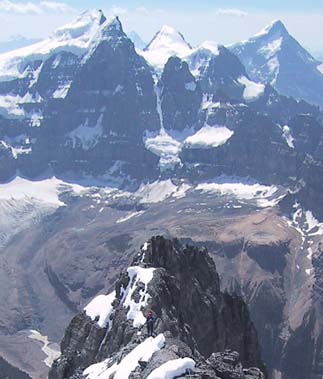
|
On the summit ridge!
Copyright © 2003 by
George I. Bell
|
At the base of the roped climbing, the Trashman had said to Homie, "I don't
know if I want to lead every pitch," and then he appended his characteristic
laugh: "Ha, ha, ha" that he does when he is nervous or scared. If you didn't
know him better, you'd guess he was kidding. Homie, not nearly the technical
rock climber that the Trashman is, wondered, "Then what am I doing roped to
you?" Later Homie would say that he'd have been fine leading any pitch on the
route, although not as quickly and efficiently as the Trashman. He's obviously
getting much more comfortable leading rock in the mountains. Homie did in
fact lead a few of the easier pitches up the gully.
While I led a short, steep pitch up to the top of the prow, the Trashman traversed
over to join our route. We were all pretty concerned about the lack of rappel
anchors and figured we shouldn't go up higher without confirmation we were on
route. We could still get down, though, by leaving our own gear and I was
reluctant to retreat.
The climbing on the third pitch was 5.6/7 and full, steep stuff. I was elated to
find ten slings wrapped around the top of the pillar and equipped with a rappel
ring. Homie remembered something about the rappel route not exactly following
the climbing route for the lower section and our confidence grew. I followed my
nose for the next four or five pitches and always found a rappel anchor from
which to belay. We were definitely on route.
Rockfall on the route was an ever-present issue. We tried to minimize it, of
course. I climbed as delicately as possible. I'd be in front the entire time, so I
was relatively safe from rockfall, but I was acutely aware of my responsibility to
the others. Another frequent and unsettling occurrence was the regular serac
falls from the glacier on the North Face of North Twin. This sounded exactly
like thunder whenever it occurred and I'd anxiously scan the skies for signs of a
storm before realizing what it was. The view over to North Twin was staggering.
What a face!
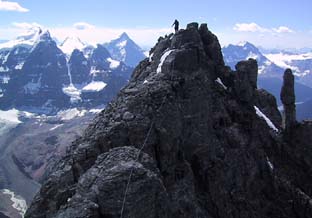
|
Homie on the spectacular summit ridge.
Copyright © 2003 by
George I. Bell
|
As I neared the crest of the ridge, I knew we had to start traversing to the right.
We needed to cross the snow gully that led to the notch in the ridge. To this end,
I led out to the right across 4th class terrain and then up to another anchor. The
next pitch would be the crux of the route for me. I traversed over and looked
into the couloir. It appeared to be ice and not snow. I debated about crossing
right there, but decided to head up the rock a bit further. Not a minute later, the
couloir was swept with tremendous rockfall. By a lucky decision, I had narrowly
avoided serious injury or death. I looked down at the belay where the Loobster
and Homie were watching me carefully. Homie said, "Good decision, dude."
I climbed up a bit higher and placed two solid pieces of gear on the near side of
the couloir. I then climbed down into it and found that I was right about it being
ice. I tried to kick a step and my boot just bounced off without even making a
dent. I could have retreated and put on my crampons, but then everyone would
have to do the same. The couloir wasn't that wide. If I could just chop some
steps across it, everyone would be able to pass it quickly. I pulled out my axe
and got to work.
Chopping furiously between furtive glances up the couloir, I raced against the
next volley of rockfall. I was nervous and knew I was directly in the line of fire.
I couldn't linger, but I didn't want to fall either. I made the steps big enough so
that I was secure. I climbed across and up, heading for a steep weakness in the
far wall. I chopped probably fifteen steps before I was across. Making the
transition to rock climbing was a bit tricky and I only managed to place one
small nut, which would eventually be pulled out because of the pull of the rope.
After only twenty feet of exciting climbing, I emerged onto a nice ledge with yet
another rappel anchor. I was so relieved.
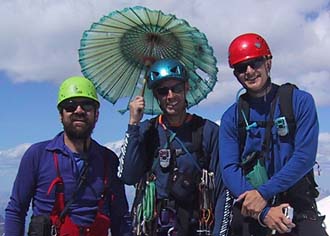
|
Myself, Bill and Homie at the summit cairn.
Copyright © 2003 by
Lou Lorber
|
The others followed easily, using my steps. I led one more long pitch and we
had gained the summit ridge. We simul-climbed the entire ridge, most of which
was pretty easy, but fabulously exposed. There was quite a bit of snow on the
ridge and it was bottomless for one brief twenty foot section where I was
reduced to swimming up it. There were occasional steep steps, loose slopes, and
even walking along a rib of snow a foot wide with drops of 3000 feet on both
sides. On this latter section, I took baby steps.
Once we had gained the ridge, we had views of even more mountains, the most
striking being the view of Mt. Columbia. This incredible mountain rises up from
the river valley on one side and the Columbia Icefield on the other side. The
north ridge of that mountain pointed directly at us and I knew this to be a
beautiful and serious route, though rated only 5.7 WI 3. I eyed the seemingly
desperate traverse across the northwest face to the start of this route and
shuddered.
It seemed forever until we finally got to the Step in the ridge. Here it was 25
meters down a 70-degree rock and ice slope. Typically a rope is left fixed here
to facilitate return. We all dug in the snow for ten minutes in search of first a
fixed anchor and then any solid cracks at all. We eventually rigged something up
from two #2 Camalots, an Alien twenty feet away, and a sling. We fixed one of
our ropes and I was the first one down, rappelling to the notch and then keeping
myself on rappel, as a belay, while I crossed the notch and gained solid ground
on the far side.
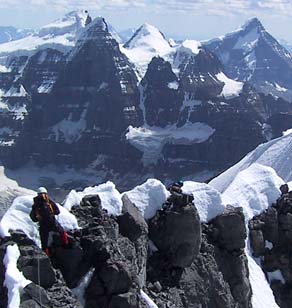
|
Slow going on the summit ridge.
On the way down before (above) the step.
Copyright © 2003 by
George I. Bell
|
Once we were all across, we all roped together with our remaining rope and
simul-climbed to the summit. We made the top in 10h40m. I was a bit concerned
about running out of daylight before we found our way down the intricate
descent. I was not prepared to spend the night out and desperately wanted to
make it back to the hut. Once off the technical ground, it would be relatively
easy to march across the talus and up the glacier. We only stayed 15 or 20
minutes on top before starting our descent. While up there we ate, rested and
took some summit photos. The summit register consisted of a few small film
canisters and from a quick glance at the register and the conditions on the route,
we figured we had made the first ascent of the year. We also found a Japanese
parasol and posed with it. What a striking contrast to this stark and dangerous
place.
We traversed back to the Step and I batmanned up the line, using a prussik to
protect myself. Once on top, I belayed the others up. Here we divided back into
two roped teams for the tedious, but spectacular ridge traverse. We did one
single-rope rappel down to a ledge. Here the anchor consisted of an old pin and
a fixed hex. I put in a #2 Camalot as a back-up and waited for the
others.
Time was of the essence if we were to make it down through the technical
portions before it got dark. Leagues of climbers have been benighted on this
descent and forced to bivy. I wasn't prepared for that and was determined not to
be one of them. Unfortunately, rappelling with four climbers is a slow process. I
was anxious and chastised the Loobster and Homie for moving slowly. Homie
bit back hard, going on a bit of a tirade. I remained mute and let him play it out.
He argued correctly that he wasn't moving slowly at all, but doing the necessary
tasks that had to be done: re-racking the gear and giving it to Trashy in order to
back-up the anchors and coiling our second rope for this first single-rope rappel.
I was overly anxious and failed to think of this, pissing off my friend with my
unjustified impatience. I was too urgent here and not helping matters.
Thankfully I settled down and the rest of the descent went smoothly and as fast
as we could, while still making things safe.
I leaned back on the rappel anchor, heard a "ping", and was immediately
dropped two feet. The Loobster was already grabbing at me, but I wasn't falling
any further. "What happened?" I asked. "The pin pulled!" said the Loobster.
Thank goodness for backups. We ended up leaving behind a new sling at this
anchor. The hex seemed good and three of us tested it. The Loobster was the last
one down and he pulled the backup Camalot before coming down.
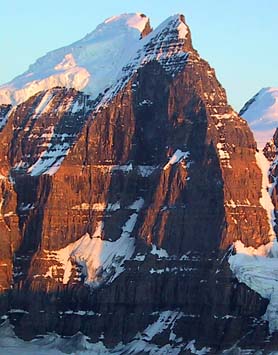
|
Alpenglow on North Twin, it's getting late!
Copyright © 2003 by
Lou Lorber
|
We continued down, reinforcing rappel anchors as we saw fit. We left a couple
of new slings and even one big stopper. We didn't want to take any chances of
an anchor pulling. At one station we used seven or eight slings to backup the
existing anchor for the first three down. The last guy down, Loobster once again,
pulled the backup and retrieved all the slings. I was usually the first man down,
searching for the next anchor and getting the ropes to fall. Trashy was our
anchor inspector and reinforcer. Homie specialized in pulling the ropes and they
never got stuck, even on the diagonal, couloir rappel. We all feared the prospect
of having to re-climb a pitch to retrieve a rope.
One rap anchor had attached to it a 20' section of cord, clearly intended to keep
the ropes from catching on, and pulling off a large pile of rubble just under the
main anchor. However this cord was sun bleached and we didn't use it. Instead
the Trashman tried to stabilize the rubble, since everyone was above he simply
shoved the loosest rocks off. These bounded violently down the gully with
tremendous force and noise, it was a sobering demonstration of how dangerous
rockfall was in this gully. Fortunately our ropes did not snag the remaining
rubble while pulling.
We made it back down to the talus and then reversed our path down the
mountain. We did a single-rope rappel at the elaborate couloir anchor at the top
of the next rock band and then we did a final double-rope rappel at the bottom of
the penultimate rock band. On this last rappel, I only clipped one of the rope
lines into my device. Thankfully, Trashy noticed this mistake and yelled out,
"Stop!" before I could weight the anchor. We then picked our way through the
last rock band and down talus to the rock-strewn glacier. It got dark then and we
trudged the last 45 minutes back up to the hut, arriving at 11:15 p.m. after just
over 19 hours on the move.
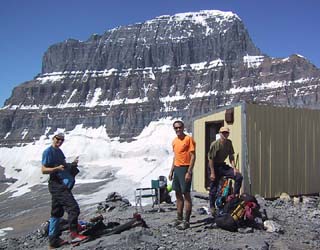
|
The morning after, everybody's psyched!
Copyright © 2003 by
George I. Bell
|
We got water and cooked up a bunch of noodles to eat, not getting to bed until
12:30 a.m. Despite the late night, I was up at 7:30 the next morning and heading
over to greet our neighbors. Another party had arrived while we were climbing
on Monday but had slept in their tent instead of the hut because they knew we'd
be arriving late and would disturb their sleep. They were headed for the same
route, and I gave them all the beta I could remember. Today they were just
headed for the high bivy so they wouldn't summit, if at all, until their third day
out. I think this is a more typical ascent. I was a bit concerned that they only had
one 60-meter lead rope and a 30-meter line to fix at the Step. That meant they
could only do 30-meter rappels on the way down. One of them said to me, "I
just figured it would be set up for 25-meter raps." What did this joker think he
was heading for? A sport climb? Supposedly they were experienced and we
found out later that both times made the top and got back down.
We lounged around the entire morning. The weather was absolutely perfect,
better than our summit day. We laid everything out to dry and there was hardly a
breath of wind. This time here was maybe the best of the trip. The scary climb
was over and successful, we were in the midst of awesome, beautiful,
tremendous mountains, but with no agenda to go anyplace scary. We just
enjoyed the views, the weather, and the company. I think we also dreaded the
hike out and wanted to put it off as long as possible.
By 1 p.m. we were starting across the glacier, heading for the highway and, for
Trashy and Loobster, some cold beers. We pounded up to Woolley Shoulder,
only 45 minutes into the hike, and took an extended break. Apparently we still
had some trouble getting motivated. Loobster had been dreading the descent but
it went nicely and easily by keeping on our mountain boots and doing an
extensive amount of scree surfing. This was non-trivial scree surfing because so
many of the blocks were pretty large - up to basketball size and you had about
twenty or thirty feet of scree moving around you. I had to be very careful so that
nothing rolled up onto my ankles. We also stuck to the gullies down below and
took advantage of any snow we could find. Still, it was long and arduous and I
was glad to finally reach the RV. We took about 4.5 hours to hike
out.
Mt. Edith Cavell
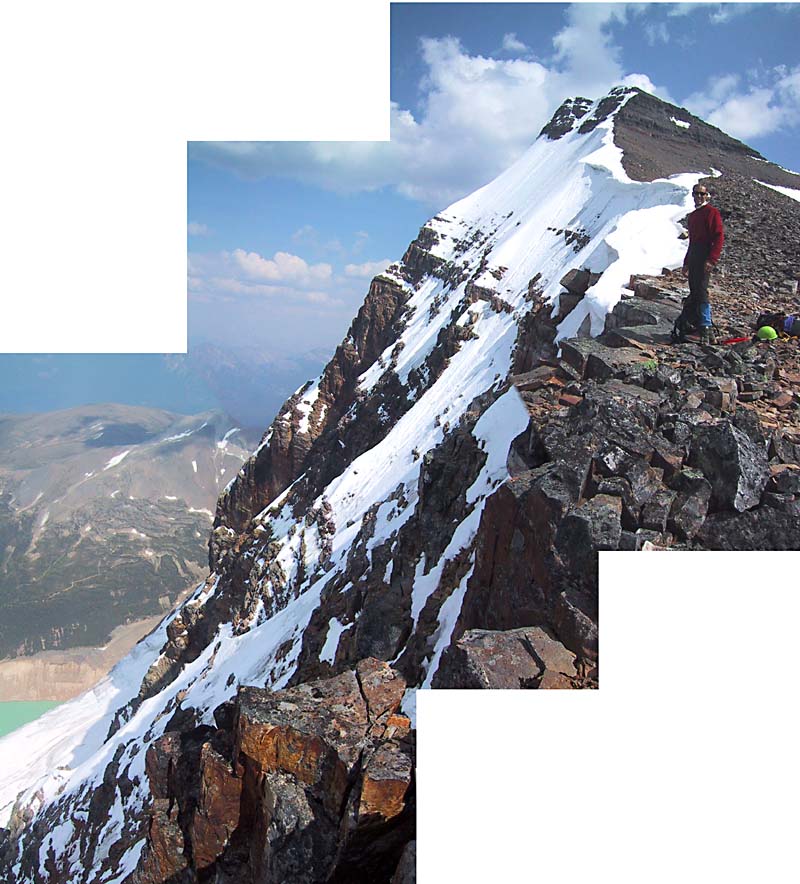
|
North Face of Edith Cavell in Profile, route follows approximately the left skyline
(composite image, taken during the descent)
Copyright © 2003 by
George I. Bell
|
Once back at the RV, we headed further north towards Jasper and Mt. Edith
Cavell. We found a very tight camping situation up there and after getting
rejected from one campground, we tried another despite the sign that said it was
full. The lady at the check-in initially confirmed the campground was
completely full so we turned around and started to head out, but when we asked
about a shower somehow it came up that they had a site, but "it was by the
garbage." Lady, can you let us decide if we want the site or not. We turned
around again to check-in and now she said, "Oh, a better site has just opened
up." No one had come by the kiosk, so no new information had come to her, yet
now, sixty seconds after we initially were told there were no spots, there are at
least two. This was my first experience with a rude and somewhat incompetent
Canadian and, yes, she was a FRENCH Canadian. I don't think that's a
coincidence.
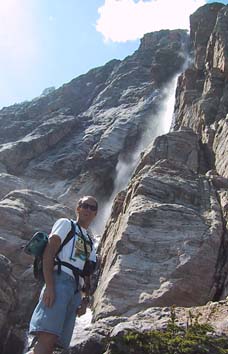
|
Recon the day before, finding a route to
the Angel Glacier left of this waterfall.
Copyright © 2003 by
George I. Bell
|
On Wednesday morning we moved a bit slow. After first waiting in line to get
an electrical site at the Whistler's campground, we eventually drove into Jasper
to see if the guys at Gravity Gear could give us a current conditions report on the
North Face. Trashy was acting a bit reluctant to get on this face, and I didn't
need anyone giving me an out. The North Face of Edith Cavell is 5400 vertical
feet from the parking lot and almost all of it is technical. It is a dark, icy,
forbidding place from which there is no escape but up. It is easy to find excuses
not to get on such a face, but the weather was great and if ever I was to do this
route, I needed to get on it now.
The owner of Gravity Gear proved to be a bit recalcitrant with route and
condition information. He warmed up eventually, but wasn't very enthusiastic
about talking about climbing. He had done the route before, but only once and
knew of no one that had done the route yet this year. His one recommendation
was to bring a picket to protect the final moves through the cornice on the
summit.
From there we headed up to check out the initial rock buttress of our route. We
had decided to attempt a one-day ascent of the route and that would require us
climbing the lower buttress in the dark. We needed to be across the Angel
Glacier and over the bergschrund before the rockfall started to heat up. Hence,
we wanted to climb the crux section of the buttress to familiarize ourselves with
it.
Trashy and I were planning to team up for the North Face while Homie and
Loobster would do the East Ridge. So while Trashy and I scoped out the lower
buttress, the other two checked out the climber's trail that led into the moraine
and from there up to the saddle below the East Ridge. Trashy and I hiked up a
well-defined climber's trail for twenty minutes to the base of the lower wall. We
scrambled for a couple hundred feet and then pulled out the rope as things got
steeper. I led up a couple of full rope lengths, noticing the lack of fixed rappel
anchors (at least for single rope raps), but not overly concerned. Once atop the
technical difficulties we unroped and while Trashy relaxed and studied the face,
I continued up the 4th class climbing to the top of the wall and up the talus until I
was looking down on the Angel Glacier. I was pleased and surprised that it had
only taken me 90 minutes from the car to get to this point. Granted I didn't have
my boots on and I wasn't carrying a full climbing pack, but we were told this
took 2.5-3 hours. My confidence grew.
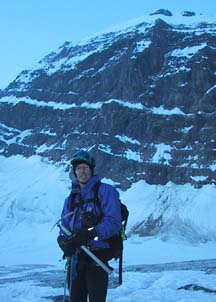
|
View of the Face from the
Angel Glacier at 6 AM
Copyright © 2003 by
George I. Bell
|
I descended back down to the Trashman and we rappelled off, leaving gear at
three of the four rappel stations. We'd be back early the next morning to retrieve
the gear. We all regrouped at the car and headed into Jasper for an early dinner.
Back at our campsite we packed for the next day. We decided to take a single
60-meter 8.1mm rope. We'd climb on it doubled up most of the time. Our
pitches would be shorter, but we'd be traveling light. I put together a rack of
nine Aliens, a full set of stoppers, two #1 Camalots, and one #2 Camalot. We
also carried seven ice screws of varying length and Homie's picket. We each
took only two liters of water and GU's and bars for food. I took two pairs of
clothes, expecting wet conditions on the ice and snow.
We set the alarm for 3 a.m., much too early for Homie and Looby, but we'd all
just ride in Trashy's rental car up to the parking lot so they'd have to live with
our schedule. They'd also get down a lot earlier than us, so they packed books
and drinks to occupy their time.
We left the car around 4:20 a.m., each party going our separate ways right from
the car. The Trashman and I headed up familiar terrain to the base of the lower
buttress. We doubled our thin rope and I took the lead. We simul-climbed the
steep section and retrieved all our gear from the day before. I led us up the upper
3rd and 4th class section and over and down to the Angel Glacier. We had taken
only 80 minutes to get here from the car.
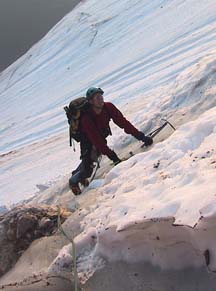
|
Crossing the bergschrund,
maximum rockfall danger!
Copyright © 2003 by
George I. Bell
|
We changed into our mountain boots and crampons and pulled out one axe to
climb the glacier. I was doing the entire climb in a thin pair of running tights. I
had some cheap shell pants, but I'd never put them on. The Trashman's attire
consisted of shorts covered in Gortex bibs. The Trashman took the lead and we
roped up for the glacier. Trashy fell in a couple of crevasses up to his crotch, but
other than that we moved steadily up to the bergschrund.
Trashy found an easy crossing of the 'schrund, then climbed twenty feet of rock
before encountering solid ice. He pulled his second tool and front pointed up
forty feet of ice to more rock and a belay. I followed and had the ice bridge at
the bergschrund collapse down four feet on me. My heart skipped a beat, but it
was over before I knew what had happened. I moved quickly over to the rock
and up to the ice.
At the belay, I stripped off my crampons and just clipped them to my gear sling.
I led up 4th class rock, unbelayed, while the Trashman stripped off his crampons
and stowed them and his axes on the pack. We reversed this procedure at the
next belay, trying to always keep the leading moving. Trashman led a long,
ledge traverse to the left. He was slowed by some ice and difficult protection. I
simul-climbed when he ran out of rope.
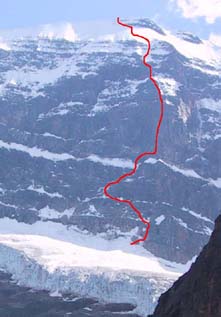
|
Our route as seen from the parking area.
Copyright © 2003 by
George I. Bell
|
When the Trashman belayed, I took over the lead. I climbed up steep, low 5th
class rock and soon we were simul-climbing again. With our doubled rope, we
could only go a hundred feet before simul-climbing became necessary. With the
Trashman simul-climbing below me, I climbed right up to the major ice band
that traversed the entire face. There were no rock anchors here and I had to
continue. It was hard ice, so, in the middle of the pitch, I pulled off my pack and
donned crampons and two tools. Before doing so I yelled down, "Trashy, are
you in a good spot? I need to switch to ice climbing gear." He was at a good
stance and patiently waited.
Once armed for ice, the crossing was easy. I nearly made it across before the
Trashman had to don his crampons. I did manage to get in a single good piece at
the start of the rock band, but we had no gear between us for at least forty or
fifty feet of climbing. Once at the rock band I climbed up to a good, protected
stance and belayed. When the Trashman joined me, we stripped off the ice gear
once again and stowed it on our packs.
The next pitch was a 5.6 chimney/slot with a few fixed pins. The Trashman led
up this, saying he wouldn't want to simul-climb it. When he ran out of rope, I
didn't want to bother him with stressful details. I pulled the belay and started
simul-climbing. I was feeling very solid climbing on this rock in my boots. I
stemmed most of the way up the pitch, while adjusting the slack in the line.
Trashman yelled down at one point, "How much rope do I have?" I responded,
"Enough."
Trashy set up a belay before the "thin traverse" and I was up the slot below
before he had me on belay. I started leading the thin traverse right over to a
pedestal below the main rock buttress. This was a bit delicate as it was steep,
sparsely protected, and running with water. The climbing wasn't too hard,
though, and I took the time to be solid. When the Trashman followed he
informed me that he'd rather not lead any of the steep rock pitches in his boots
as he wasn't feeling that confident in them. I was feeling great and agreed to
lead the rest of the rock on the route. Trashy was our designated "Ice Man",
because he was a much better and more experienced ice climber. I wanted him
to arrive at the thousand-foot summit icefield feeling mentally fresh and ready to
go.
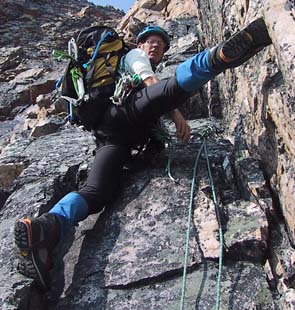
|
Bill casually cruising the crux rock pitches.
Copyright © 2003 by
George I. Bell
|
Just like on Mt. Alberta, Trashy and I were retreated to the cacophony of regular
serac fall. This time it was the Angel Glacier below us that calved off every
couple of hours. Rockfall was also a danger and rained down upon me a couple
of times down low, before we got up tight to the steepest features, and a few
times on the upper mountain when debris rained down the weaknesses we
climbed.
We were now below a very steep buttress. The rock on Edith Cavell is not the
crumbly limestone that we found on Mt. Alberta, but is very solid quartzite that
fractures into very flat, positive edges. The climbing for the next four pitches
was nearly dead vertical, but was peppered with numerous great hand and foot
holds. The climbing here is rated 5.7 and we mostly agreed. We thought one
pitch was about 5.8. The cruxes on each pitch seem pretty short and then you get
a great rest, frequently standing on a three-inch foothold to place gear. In fact, I
never was stressed placing gear as I always had a good stance. We still climbed
on our doubled rope, as the pitches here are pretty short. Clearly we could have
combined them by using just the single line, but belays set-up quickly and we
moved well, covering these four pitches in just over an hour.
Above the buttress was lots of mixed climbing. I'm sure most climbers would
switch to ice gear here and stick to the ice, but I'm a rock specialist, and I pieced
together rock islands for three or four more pitches up to the final rock buttress.
I stemmed across ice sections, sometimes cut a step in the ice, and kicked up a
small snow section to avoid putting on the crampons. At one point, I climbed
through some very loose rock and had to run things out fifty feet or more to a
marginal belay. We simul-climbed a lot of this section, but re-grouped for gear a
few times.
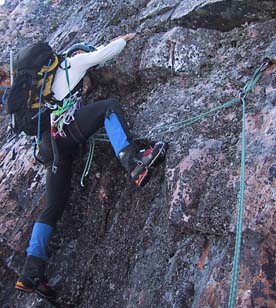
|
The crux slimy rock moves.
Copyright © 2003 by
George I. Bell
|
At the final rock band, I led up one pitch to the base of a very intimidating wall.
It was dead vertical, mossy, wet, and with limited protection possibilities. A
fixed pin at the start was evidence that we weren't the first to run into this
obstacle. I brought the Trashman up to give me a good solid belay. Our belay
anchor was just wrapping our lead rope around a huge spike of rock on our
sloping stance. I climbed up steep snow, trying not to crush it down too much
since it would serve as my last good foothold, and clipped the old pin. I could
reach up and get my hands on a big edge that sloped up and left. It also sloped
out a bit and wasn't very positive. I basically did a pull-up on this hold and put
my right boot on a quarter-inch edge. I then hand traversed a bit up and left and
then hung from my hands as I swung over to the left and a good foothold for my
left foot. I jammed in what I thought was a marginal Alien, but I'd find out later
that the Trashman aided off this piece. I had to do one more fairly intense
climbing move to get up to easier ground. This climbing was at least 5.9 and the
Trashman thought it was 5.10 (certainly felt tough with boots and pack) before
he decided to aid it.
I continued up easier rock searching for a decent belay anchor, but never finding
one. I eventually got in three marginal pieces and braced myself in loose rock to
hold the Trashman. I was very relieved that he didn't come off climbing this
section and when he joined me at the belay, we switched to ice gear for the last
thousand feet of the climb.
Trashy led out right into a prominent, broad couloir. The ice surface was
covered in 6-8" of wet, slushy snow. The snow generally wasn't enough to stand
on and we'd have to use frontpoints and two axes to gain ground, but
occasionally we'd be able to stand flatfooted in the snow and it provided a
welcome rest. The angle was about 55-60 degrees, considerably steeper than we
had anticipated.

|
Looking down the final snow field.
Copyright © 2003 by
George I. Bell
|
Trashy went out about fifty feet, now climbing on a single line, and got in a
piece of rock protection at an outcrop. Fifty feet higher, he put in an ice screw
and fifty feet above that, more rock gear. After he ran out two hundred feet of
rope, I started climbing behind him. Trashy was working hard on the front,
breaking trail and setting all the screws. He was stressed about snow conditions
and fearful that it would slide. After about five hundred feet, he looked down to
see a single ice screw between us. The void tugged at his mind and he was not
comfortable with the situation. I wasn't that stressed out. I had Trashy leading
the way and doing a great job. I felt there was no chance I'd fall and if I did, the
forces would be low and the screws would hold. If the entire slope slid, we'd be
in trouble, but we had no choice in our route and worrying about that was not
productive for me.
Trashy was now in deep snow, a foot and a half deep, and he couldn't find any
ice for protection. Finally he dug down deep into the snow and placed two
bomber screws. I climbed up to join him. He wanted me to lead a pitch up to
near the summit. We had probably 300 or so feet to go. I took all the screws and
set off up the slope. I found an ice runnel and followed it for a long ways,
heading straight for the forbidden shale at the top. I followed this route because
it was pure ice and I didn't have to excavate placements and I didn't have to
break trail, but I knew I'd have to go left around the shale. After two hundred
feet and using all the screws, save two for a belay, I stopped to bring Trashy
up.
When Trashy arrived and looked up at the intimidating shale and vertical top-
out, he hesitated a bit. I could tell he didn't want to lead any more. He had done
more than his share of the ice climbing. I offered to take the lead and, somewhat
relieved, he accepted. He then said, "How come, after your accident, you didn't
become more fearful of climbing?" It was a curious thing to say at a time like
this, but he followed it up with: "I find that as I get older, climbing scares me a
lot more than it used to." I wanted to reassure him and answering honestly did
so. "Trashy, my accident was a mistake. Actually, a whole series of mistakes. I
understand what I did wrong and I've learned from it. I know climbing is
dangerous, but I'm fitter now, I'm more experienced now, and I'm more
confident in my abilities now. Hence, I fear less."
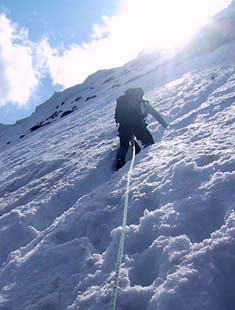
|
The final pitches up to the shale band.
Copyright © 2003 by
George I. Bell
|
I took off on the final ropelength, placing screws every forty feet of so. I placed
my last one maybe thirty feet down from the summit. I knew it would be my last
piece. I had a picket strapped to my pack, but I wouldn't bother pulling it off
unless nothing else worked. I followed ice to within ten feet of the lip and then it
turned into vertical snow. This section was the most precarious of the climb for
me and I slipped down a few heart-stopping times, before catching in the snow. I
finally hammered on of my axes into the hard snow as a picket and then mantled
onto it, rolling onto the summit. We'd done it.
My hands were completely numb from being in the wet snow for so long. I put
in a piece and stripped off all my gear. I managed to get Trashy on belay before
the agony of defrosting hit me. For the next ten minutes I cussed silently in
tremendous and all-too-familiar pain. This was one of the reasons I don't ice
climb anymore. This pain is horrific. I like alpine climbing, though, and I'll
continue, but I need better gloves for this stuff. I figured it was a warm summer
day and didn't think of the obvious: wet snow is cold, no matter what the
season.
Trashy soon joined me on the summit and we were both elated. I gave him a
hug. What a great partner and companion he is. I'm lucky to have done a
number of my biggest climbs with him. This was our sixth 50CC climb together
and that list included The Titan, Direct South Buttress of Mt. Moran, the North
Face of the Grand Teton, Shiprock, and now Mt. Alberta and Edith Cavell. He's
rock solid. I walked over and tagged what looked to be a higher summit to the
east. Of course, from there, the true summit a bit to the west of our top-out
looked higher. We signed the register and noticed the entry for Homie and
Loobster. I was a little disappointed that they hadn't left us a note, maybe with
the summit time so that we'd know how far behind we were.
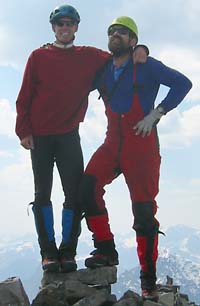
|
On the summit!
Copyright © 2003 by
George I. Bell
|
A father and son team had just topped out on the East Ridge and while we
relaxed and ate, we watched them flail on the descent. They obviously started
down the wrong way and after a hundred feet of descending, then climbed back
up. They started down the correct way, but peeled off too soon and were
downclimbing some horrible loose section when we went by them. They had
done a number of good mountains while up here on vacation from Georgia,
though, and I wondered how they pulled it off.
The West Ridge descent is best left unmentioned, but I'll make a few comments.
It starts by descending 3200 feet of mostly nasty talus and scree. Most of it
moves and most of it is far too large for any scree surfing. Tired from our ascent,
we had to be careful not to injure ourselves, but we also wanted to get down and
get back to the car without delay. Once off the unpleasant upper section, we
found a beautiful climber's trail that led us all the way down to the Tonquin
Valley trail. Once down on this nice flat trail, I set a motivated pace, mainly to
end the hiking as quickly as possible. Only thirty minutes from the car did we
finally switch out of our boots and into our sticky-rubber shoes. I decided to
hike fast until 15 hours had elapsed and if I wasn't done by then, I'd take things
easier. I finished in 14h59m. Things just worked on this climb.
Homie and Loobster had been down for 2.5 hours, but they still seemed in good
spirits and we traded stories about our climbs. They had taken things easy and
slow, knowing speed would only grant them more waiting time down at the car.
They ascended in 6.5 hours, spent over an hour on the summit, and completed
the roundtrip in 12.5 hours. They remarked seeing that someone claimed a 3-
hour ascent of the East Ridge. They enjoyed the descent route every bit as much
as we did. Homie remarked that he was a bit disappointed by the lower part of
the ridge, as it was trivial Class 2 climbing. The upper section redeemed the
route for him and he enjoyed the fun, exposed scrambling. They had brought a
small rope and rack, but used neither. The crampons and ice axe were only used
briefly as well, so they were more heavily burdened than necessary.
We headed back to the campground for a revitalizing shower and a hearty meal.
On Friday morning we slept in until 8 a.m. and then unpacked the gear and
stowed it away. By 9:30 a.m. we were headed into Jasper for breakfast and
shopping. We managed to kill most of the day lounging around Jasper. I like this
little town. This would be our one complete day of rest on the trip, besides the
drive up and back, of course, but those aren't all that restful when you never
stop moving.
Yamnuska
A month ago, while celebrating my tenth anniversary up here with Sheri, I
climbed my first and only route at Yamnuska, the storied limestone cliff twenty
minutes west of Canmore. Most of the luminary Canadian alpinists have left
their mark on this thousand-foot precipice. Sheri and I had hiked to the top of
the mountain and then I scampered up a 5.5 route called Easy Street in my
running shoes. The climbing was fun and I wanted to go back for more. We
planned on climbing at the cliff until noon on Saturday and then heading for
home.
Fires were raging all over the Canadian Rockies. In addition to the fire near
Jasper, we encountered one near Lake Louise on our way back south and then
the worst smoke was around Canmore. We could barely see Yamnuska as we
drove toward it that afternoon because of the smoke in the air. We noticed the
"No Camping" signs as we pulled into the parking lot, but hoped that no one
would check on us. We tried to get a site in Banff, but they were full and told us
everywhere else would be full as well. Just before midnight a conservation
officer banged on our door and rousted us. Still half asleep, I opened the door
prepared to give our sob story of no campsites. He said, "You guys are illegally
camping here. I'd write you a ticket, but you're from Colorado so I have two
options: arrest you or get you guys to move. I prefer the latter." "So do I," I said.
He told us the campground just down the road still had some sites and in less
than a minute we were driving out of there.
The next morning we were treated to a drunken woman screaming obscenities of
the vilest nature nearly non-stop at her male companion. I half expected it to end
with gunfire, but, apparently and luckily, neither was armed. We racked and
packed and headed for the cliff parking lot. We were hiking by 7:15 or so and I
was setting a hard pace to make up for lost time. The pace was hard enough and
the trail steep enough to blow apart the peloton. First to drop off was the
Trashman. After a thousand vertical feet, the Loobster cracked, let Homie pass
him, and fell off the back. Homie and I dueled up the hill like Armstrong and
Ullrich. I hiked as fast as I could, but still Homie was breathing down my neck.
He wasn't even breathing hard. I was huffing and puffing, but trying to
minimize the noise and being in front helped this effort. I'd consciously breath
slowly whenever rounding a switchback so that he wouldn't know I was
working so hard, but the sweat streaming off me was a telltale sign.
We did the 1500-vertical-foot approach in 38 minutes and threw down the packs
directly under our chosen route: The Grillmair Chimneys. This 8-pitch, 5.6 route
was the first one done on the cliff back in 1952 by Leo Grillmair, Hans Gmoser
(later CMH heli-skiing founder), and three others. This was a 2-star (out of 3)
route, very popular, and I was sure we could climb it quickly.
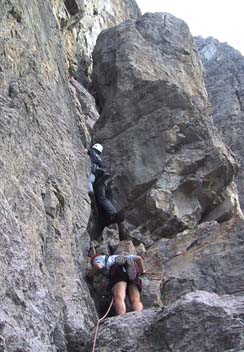
|
Loobster following and Homie leading the crux pitch.
Copyright © 2003 by
George I. Bell
|
We should have climbed around the loose scrambling directly below the route,
but I just headed up instead, dragging the rope behind me and knocking down
some rocks. I roped up with the Loobster and Homie and Trashman followed us
as a separate team. I led quickly up the first pitch, placing a single piece and
brought the Loobster up. The next pitch up behind a giant pillar was
considerably tougher and probably the crux of the route, at least the way we did
it. I climbed up a steep crack to the left of the huge chimney and then traversed
into the chimney and up to the top of the pillar. Homie led this pitch in the same
fashion and was slowed by the steep crack, falling behind the Loobster and I. I
climbed a bit fast here as I had all three of them waiting on me as I led the
second pitch. I don't like to be holding up so many people, so I worked to get a
bit of a gap and reduce the stress on me.
I ran up another couple of fun pitches. At the top of the fourth pitch I yelled
down to Homie, "Nice job," as he topped out the second pitch, but got no
response. At the time I thought he was either pissed, stressed or both. I
figured my pace might be adding to his woes and the Loobster and I continued
at a much slower speed. As it turns out he probably just didn't hear me or I
didn't hear his response. Homie was happy and psyched about the route when he
got to the top, so I probably worried needlessly. The climbing was all fun and
mostly easy so it went quickly no matter what I did. We took lots of photos and
moved casually the rest of the way.
The final pitch is by far the best on the route. From the start of the pitch, things
look intimidating. A chimney leads steeply to the top of the wall , apparently
finishing up a steep headwall. Fortunately, we knew the route burrowed into the
chimney and topped out via a hole in the back. Even the initial chimney didn't
really require any chimney technique. We all stemmed up the outside of the
chimney via great hand and footholds that were unseen from below. This pitch is
festooned with fixed pitons, more than the rest of the route combined, so it was
well protected too. I could barely squeeze through the hole at the top with my
Camelback on but once I did I was on flat ground. What a cool finish to a climb.
This route is highly recommended as a fun romp.
Both this route and the Japanese Route on Mt. Alberta are rated 5.6 and both
ratings are accurate, yet the former feels like a very serious endeavor while the
latter is just a casual romp. Using just the technical rating to compare these
climbs is a joke. The technical climbing on the Japanese Route is at least 50%
longer than this route, the protection is considerably worse, the rock quality is
much worse and the rockfall danger much greater. These two routes greatly
contrast the differences between alpine climbing and cragging and competence
at a particular cragging rating does not imply competence at the same alpine
grade.

|
Homie leads the spectacular final pitch.
Copyright © 2003 by
George I. Bell
|
Loobster and I waited for Homie and Trashy at the top, taking photos of each
one as they popped out the hole at the top like a couple of prairie dogs. Homie
had swung leads with Trashy all the way up and just by chance had led most of
the harder pitches. Homie could be a lot better rock climber if he cared enough
to do it more. I guess it's enough to be the intercontinental mountain
champion.
We hiked down the trail to the east end of the cliff and then along the base
towards where we left the packs. I wanted more. Loobster had been concerned
about getting back to Boulder pretty early on Sunday, but he was game for
another quick route. Homie was content with having done the one route and was
feeling "grumpy," which I now know means he had to dook, so he headed back
to the trailhead. I actually thought he was truly grumpy. Homie gets real quiet
and uncommunicative when he's unhappy. Trashy decided to placate his wife
and forego the drive home with us and another route. He booked back to his
pack and headed for the airport to catch a 3 p.m. flight.
The Loobster and I headed up a route called Dickel that is three pitches long and
rated 5.7/8. Looking up from the base at the crux second pitch was a bit
intimidating. A vertical corner was split by a crack and the climbing looked
sustained. I pulled on my slippers, tied into the rope and made my way up the
first pitch. The guidebook gives this route one star and says that it deserves more
traffic. We'd soon readily agree.
I climbed up and right beneath a roof and then up steep rock to a tricky move
back to the left and the fixed belay. I thought this move was 5.7, but the pitch
was only rated 5.6. The Loobster followed quickly and I headed right on the 5.7
traverse that starts the second pitch. I clipped one fixed pin and then moved up
into the steep corner. The climbing here was fabulous, the best of the day. Very
steep climbing was protected nicely by the accommodating crack. Four-inch
footholds providing good rests and pro-placement stances interrupted steep
challenging climbing. I clipped a few pins and placed a couple of pieces before
getting to a nice stance. I threw in four pieces of gear, expecting the Loobster to
have some trouble on the pitch, but I needn't have been so cautious. The
Loobster waltzed up the pitch easier than I did. His decades of rock experience
can compensate for nearly a year without much rock climbing.
The last pitch was easy and I was on top in only a few minutes. The Loobster
followed and we both made the top in less than an hour from the base. Fifteen
minutes later we were back at the base of the route and thirty minutes after that
we had retrieved our packs from the base of the Grillmair Chimneys and were
back at the RV, driving toward home.
Getting around and through Calgary was the usual mess. Why a city of over a
million people doesn't have a highway through it is either a testament to their
love of traffic lights or their lack of wanderlust. We simplified matters this time
by just biting the bullet and taking Highway 1 East right through town to
Highway 2 South. This was slow and annoying, but relatively simple, except for
the monkey business on 2 South.
The drive home was long and hot, but thankfully uneventful. Loobster again
panicked at the border crossing. This time he lied about the value of the goods
that he bought. Having purchased a $500 Ammolite gem for his wife Martha,
when asked by the border patrol for the total value he said, "Ah, $35?" What a
Loobster.
I wrote this trip report when it wasn't my turn to drive. These trips are great
because you're excited to go on them and have lots of fun anticipation; they are
fun to do with all the nice climbing and great companions; and, finally, they're
great to come back from as I missed my buttercup and my two boys.
 Trip Report Index ...
Trip Report Index ...





